

© Shipping Wonders of the World 2012-

Chinese Piracy
Although piracy has been stamped out in Western waters, the coastal waters and rivers of China are infested with pirates who are not deterred by the elaborate precautions which are nowadays made against attack
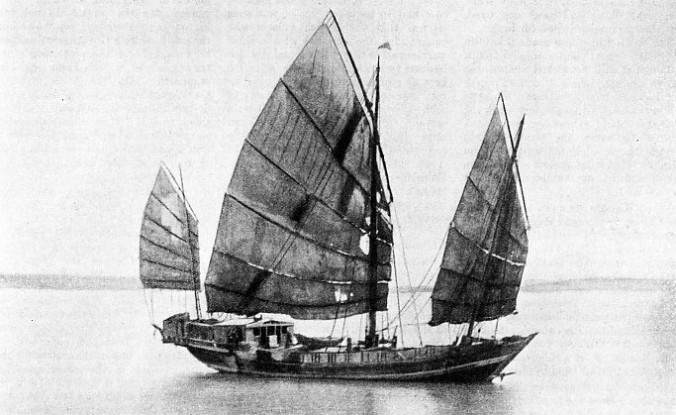
THE TYPICAL NATIVE RIVER CRAFT of China is the junk, which has survived with little alteration for thousands of years. In the early days of merchant shipping in Chinese waters, the pirates would attack and board sailing ships from junks. With the advent of steam the pirates changed their tactics, and they now generally embark disguised as passengers.
THERE are many people who hold a comforting belief that piracy is dead, and that the overseas traveller is now as safe as the traveller in an English railway train; but the naval officer who has the job of policing the seas knows perfectly well that there are a score of areas in which piracy would become rife in a month were it not for the fear of the man-
The most important factor which will always be of paramount influence is that the average Chinese does not see anything immoral in piracy, which is to him an excellent means of earning a living as practised by his forefathers for countless generations. It is a living accompanied by an element of risk, but that does not worry him unduly. The local mandarins always made a large part of their income by piracy, for they could never be sure of their official pay. Nowadays the republican officials, local mayors or temporary generals take precisely the same view of this opportunity of making money.
In the early days of European trade with China the pirate always had to be reckoned with and all the ships were armed. The East Indiamen carried their two long tiers of guns, and standing orders always enjoined particular care while vessels were in Chinese waters. At a later date, when there was peace in Europe and the ordinary merchantman was no longer armed, the clippers in the China tea trade always carried their battery of guns and a full supply of muskets and pistols in the saloon. Long after the tea trade was done and the ships were sailing on other services these arms-
Attack was then to be expected from outside, particularly when a sailing ship was becalmed or when a steamer was broken down or anchored waiting for water. Powerfully armed junks would bear down on her, opening fire with their guns at the first opportunity, but always striving to board and overcome the crew by weight of numbers in hand-
As a rule the junks were well armed and carried immense crews. Luckily these were usually exceedingly bad artillerists, and a cool European crew, even a small one, could generally prevent their coming alongside.
Whole fleets of piratical junks were to be expected, fleets which had long preyed on any native craft which came their way and which were tempted by the bigger loot offered by a European ship. Time and again naval operations had to be undertaken on a large scale, and pirate fleets and bases destroyed, but the relief never lasted for long.
The coming of steam made this form of piracy more and more difficult, although it still flourished against the native trading junks and caused appalling loss and misery to them. To hope for any success with a steamer — and the enormous loot in prospect made the risk worth while — the pirate had to change his methods and operate from within. That is the system in operation to-
When Western steamers appeared on the Chinese coasts and rivers they soon attracted all the business that was really worth while. The shipper with valuable cargo to be transported chose one of them in preference to a junk, not only for her speed, but also for her safety, and the steamers soon provided the principal passenger-
A party of them, externally indistinguishable from the hundreds of coolie passengers, would board the ship and at a given signal rise, taking the handful of white officers by surprise, and capture the vessel, which they looted at their leisure. The various Western navies stationed gunboats and cruisers on the rivers and coasts from an early date, but the movements of these ships were carefully watched by the well-
Carefully Laid Plans
In the old stern-
There were pirates on board who soon noticed that one doorway was uncovered. Both officers were shot from behind and the ship was quickly looted of everything of value. As a general rule the pirates do not take life wantonly nowadays, for they realize that with modern Government methods they cannot get the protection which they used to expect from the local mandarin. On the other hand, if there is the least sign of resistance they do not hesitate to shoot and invariably shoot to kill. They make their plans so carefully, and are so patient in their execution, that there is seldom any chance of effective resistance in any circumstances.
On the Chinese rivers, where most of the piracies take place, there are two recognized seasons. The first starts immediately before Christmas and lasts till the middle of February, covering the Chinese New Year, which is a season of general festivity and of an immense amount of travelling by the wealthier people. The second is in June and July, when the rivers are at their. height with the melted snow coming down from the mountains and the steamers busier than at any other time. That is the great gambling season and the thousands of Chinese professional gamblers find the river steamers their most profitable haunts.
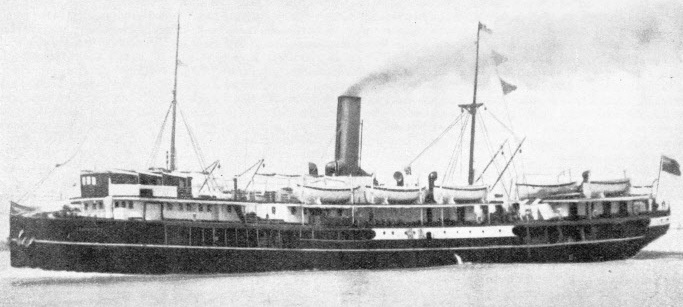
TRADING ON THE CHINA SEAS, many vessels such as the Tungchow are attacked by pirates. The Tungchow was captured by pirates in 1935, as described in the chapter “Gunboat Patrols in China”. A vessel of 2,104 tons gross, she was built in 1914 at Hong Kong and belongs to the China Navigation Company, Ltd. She has a length of 280 feet, a beam of 40 ft. 1 in. and a depth of 17 ft. 9 in.
During the off season the majority of the pirates have been at home in their villages, tilling the ground or doing a little fishing. These villages are generally well known as pirates’ headquarters, but as they are in Chinese territory the foreign men-
Bias Bay, near Hong Kong, has been well known as a pirate centre for centuries. Another famous centre for river work is an island near Kumchuck, which covers the approaches to Canton and its immense river trade. There are thousands of pirates or semi-
Provided with this excellent intelligence, the pirate makes his plans with minute detail. Everything is perfectly organized and every man has his own particular job. The ships’ officers are the business of two or three. Others have to deal with the armed guard, if one is carried. All of them take their tickets as ordinary passengers and mingle with the hundreds of other coolies on board, behaving just as they do, but always keeping in a position from which they can watch the leader give the prearranged signal. This will not be given until everything is perfectly set for the attack. Perhaps no opportunity will offer itself during a river trip lasting several days. That does not matter. The Chinaman is always patient, and the pirate band quietly disembarks at its destination to await the ship on her next passage.
When everything appears promising the signal is given, and in a moment the attack is made. Officers and passengers will be covered with revolvers. One pirate will be at the wheel and another on the starting platform of the engine. Certificates of competency granted by the British authorities at Hong Kong are the highest-
Pirates' Headquarters
A careful look-
Occasionally the pirates make a miscalculation, but as a rule their plans are perfect, and are carried into effect smoothly and most effectively. There was one instance on the West River before the war of 1914-
It was a day of the worst of luck for the pirates. They had in their band a young native of eighteen who, although brought up in a pirate community, had never been on a venture before. He shipped as a passenger in the same way as the rest, a revolver concealed in his clothing, but when the ship was boarded in the routine manner by a party of Chinese Customs House officers he lost his nerve and fired instead of waiting until the signal was given.
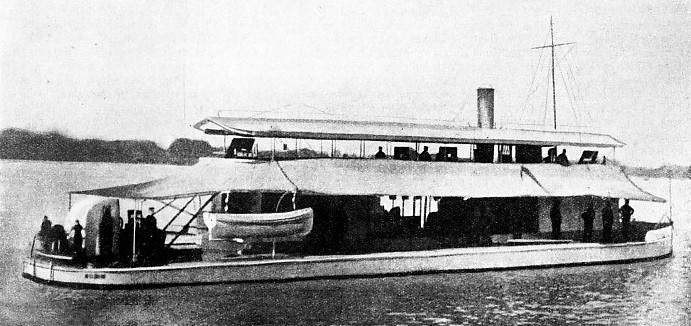
A SHALLOW-
The leader made the best of a bad job and gave the signal for an immediate attack. The man who was stationed at the engine-
The marksmen could soon pick off anybody who tried to jump overboard and make for the shore, so that the pirates made use of their usual dodge of throwing their revolvers overboard and mingling with the native passengers. The bluejackets boarded and drove all the Chinese into the holds, where one seaman stood on guard over each hatchway while the ship was searched. The leader was discovered in a cabin with half his jaw shot away. Thinking that his hours were numbered, the naval party sent him ashore to be dealt with by the native magistrates, only to discover when he was moved that he had two fully-
The bluejackets on board the captured ship had the task of sorting out the pirates from the innocent passengers, a job which appeared hopeless, for there was nothing to distinguish them externally. The pirates had all jettisoned their weapons, and it was certain that none of the passengers would dare give the show away. Help came from the young pirate whose nervousness had ruined the whole affair. In his terror he volunteered to turn King’s Evidence.
He was taken into a boat stationed just outside the entry-
In this particular instance there was another incident which shows the methods of the pirates, and explains the terror with which they are regarded by the ordinary inhabitants. When the men-
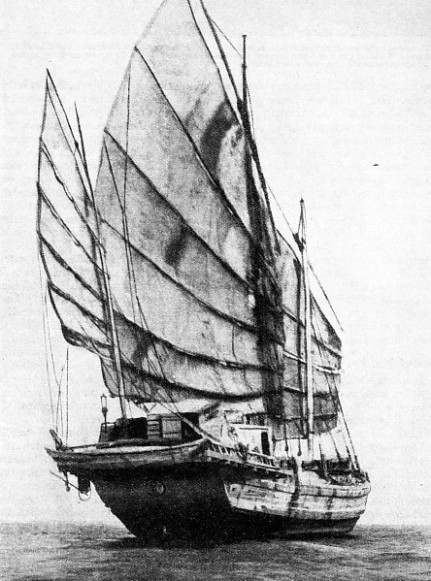
A LARGE CHINESE JUNK which was suspected of piracy, although no definite proof could be found. Nowadays such junks are used by pirates against ordinary native craft, but rarely in an attack on a steamer, although after the failure of the attack on the Tungchow (illustrated above) the pirates escaped in a junk.
In such circumstances it is not surprising that the native population will not render any help against the pirates, even when they are not actively allied to them. The dice are heavily loaded against the International Gunboat Patrol, and everybody who has to do with shipping in Chinese waters appreciates the risk under which it is carried on. With typical fatalism many Chinese business men who have to use the river steamers to any extent put aside a sum in gold every year, just as the ordinary man puts aside the premium on his insurance policy. Sometimes this money is left in charge of a bank, for use as a ransom when occasion should arise.
In 1914 the Hong Kong Government framed the Piracy Prevention Ordinance, by which all British vessels trading from the colony were to carry armed guards of Indian Sikhs; but even the most alert guard must have his moments of relaxation, and the pirates wait for these. In spite of that the system of guards is effective, and is generally carried out when possible.
Too much cannot possibly be said for the work done by gunboats on the rivers. Nearly all the maritime countries whose ships use the Chinese rivers and coasts maintain these gunboats, some more and some less, but there is a feeling that some Powers whose shipping enterprise has given them considerable trade in Chinese waters are inclined to leave the protection of their ships to the other Powers. Great Britain, Japan, the United States and China maintain the biggest fleets, although the efficiency of the Chinese varies greatly according to the area and the officers in charge of the ships.
The modern China gunboat, as she has come to be called, is a twin-
The shallow draught is obtained by building two deep tunnels into the hull and placing the screws in them. When the ship is going ahead the water fills these tunnels, and the upper parts of the propellers are working in solid water which is above the level of the river. By this means a gunboat of 650 tons, mounting two 6-
Night Attack
Although the gunboats, and the deeper-
The British steamer Haiching, for instance, one of the best-
The officers off watch rushed from their cabins to the bridge, but the third officer was killed before he could reach it and the chief was wounded. Had the pirates been able to keep their schedule to perfection there would have been no hope for the ship or for her people. As it was, the pirates were a few seconds late in the attack on the bridge, and when they did attack the captain and officers were able to defend it. The pirates attempted to burn them out by setting fire to the cabins under the bridge, but, maintaining a steady fire and helped by the Sikhs, the officers drove the pirates aft, where they fortified the poop and fought for about three hours.
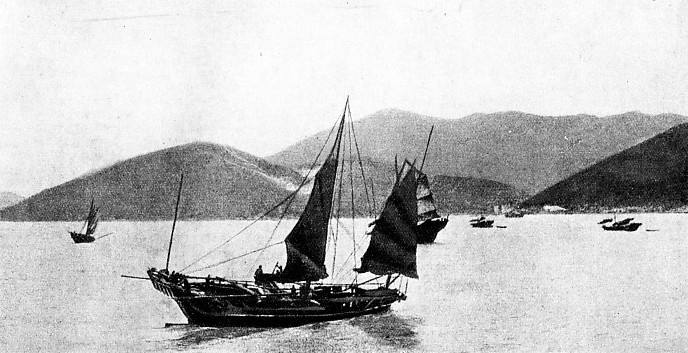
FAVOURITE LAIR OF PIRATES, Bias Bay lies about 50 miles east of Hong Kong. The bay is the headquarters of a large pirate organization. The movements of merchant vessels and gunboats are reported by spies and captured ships are often brought to Bias Bay to be looted.
By that time the pirates realized that the attack had failed and, knowing that an S O S message had been sent out, they attempted to get away in the ship’s boats. Native passengers were seized and used as a screen for these operations, but the white officers contrived to prevent it, and the fight was still going on at past six in the morning when a British destroyer dashed up at full speed, finding the unfortunate Haiching blazing furiously. With her own facilities and those of the warship’s the fire was suppressed and about 350 Chinese passengers were disembarked. What would have happened to the ship, attacked by such an unusually desperate gang, had it not been for the coolness of Captain Farrow and his officers may well be imagined.
There have been many other instances of ships contriving to foil piratical attacks, or escaping after they have been captured, and among these the Sunning is conspicuous. She was a ship built in 1916, of 2,555 tons gross, owned by John Swire’s China Navigation Company, one of the biggest concerns on the China Coast. She was designed for cargo and passenger carrying on the coast, and was a popular and successful ship until she was destroyed in a typhoon in 1936.
Her success and regular plying on the coast had made her a particular mark for pirates, and in 1923, while bound from Hong Kong to Kongmoon, she was attacked by a gang of pirates who had shipped as passengers. Captain McKechnie and his chief officer were fired at without warning and seriously wounded. One of the Sikh guards was wounded and the other two were overpowered, whereupon the pirates took what loot they wanted and decamped.
In November 1926 she was bound from Amoy to Hong Kong, when another attack was made in precisely similar fashion. The band of pirates was strong and their organization was perfect. In an orderly manner they got into position and every officer of the ship suddenly found himself covered and disarmed. There was no possibility of resistance, and from the pirates’ point of view everything went off without a hitch. That must have made them rather over-
A Desperate Fight
Their chance came in unexpected fashion. Six white men, including most of the officers, and a Russian lady passenger, were locked in the chief officer’s quarters for the night, and there they found two revolvers and a fair supply of ammunition which the pirates had overlooked. While the men were planning to use them events were happening on the bridge, where Captain Pringle and Chief Officer Tom Beatty were being forced to take the ship to Bias Bay. Chilang Point is the leading mark, and Mr. Beatty suddenly pointed into the darkness, “There’s Chilang Point”. The captain grasped the situation and handed his binoculars to one of the guards.
While the two pirates were searching the darkness Mr. Beatty possessed himself of the deep-
The situation was critical. There were forty desperate pirates fighting for their lives and only a handful of Britons with limited ammunition. Fortunately, Captain Pringle contrived to get one anchor let go, which brought the ship’s head into the wind and swept the flames down on to the pirates, who were crowded into the afterpart of the ship.
The chief engineer, Mr. Cormack, had been wounded while the pirates were using him as a shield, but the rest were full of fight and the attackers decided that their only chance was to escape Two of the after boats were in their possession. These were lowered, and as many pirates as could do so made their escape in them. The flames attracted the attention of passing ships, who wirelessed for help, and also of H.M. sloop Bluebell. It was one of the finest fights in the history of the Merchant Service. Mr. Beatty was properly honoured, and the majority of the pirates were captured, to receive their deserts.
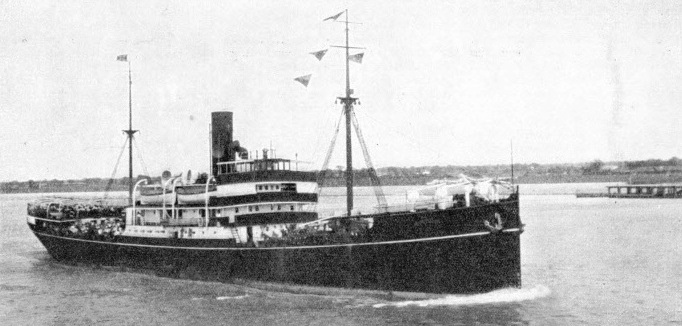
CAPTURED BY PIRATES IN 1926, the Sunning was saved at the last moment by the outstanding bravery of her officers, who recaptured the vessel and drove the pirates off. The Sunning, 2,555 tons gross, was built in 1916 at Hong Kong. She had a length of 310 ft. 4 in., a beam of 41 ft. 2 in. and a depth of 22 ft. 5 in. She was lost during a typhoon in 1936.
You can read more on “China’s Mighty River”, “Gunboat Patrols in China” and “The Kung Wo” on this website.